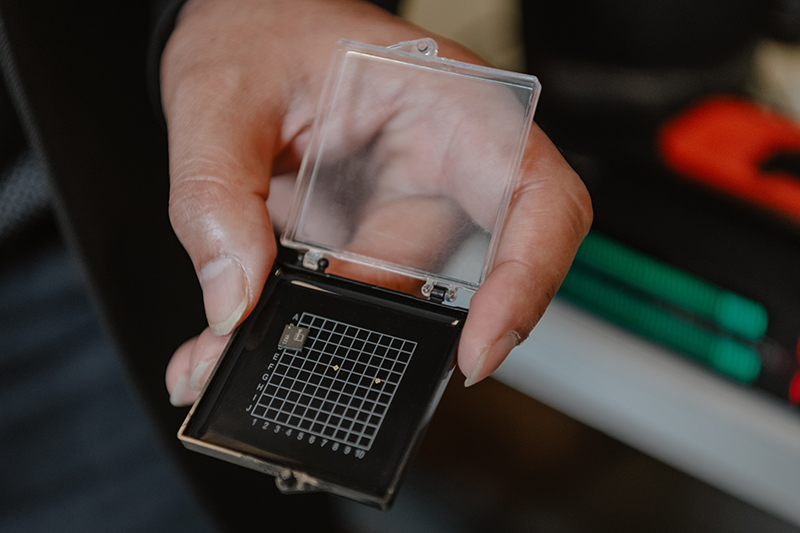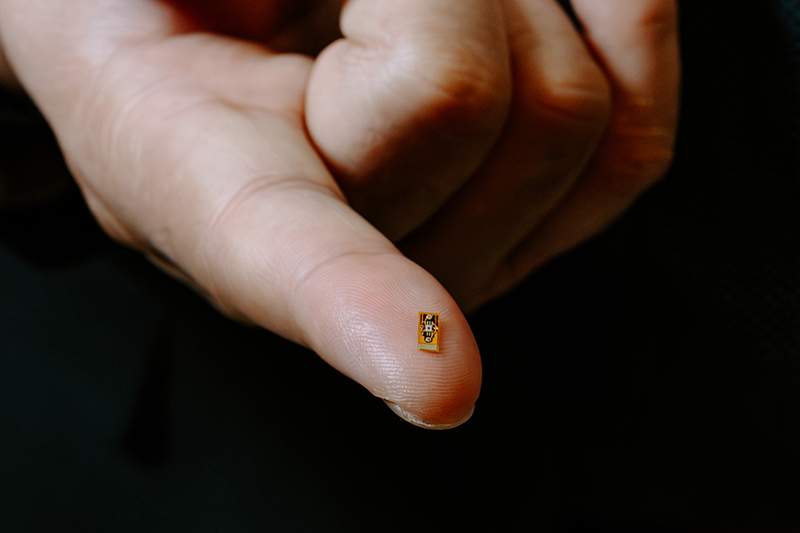December 4, 2023 Purdue University
One day, humans might be able to use their touch and thoughts instead of screens to interact with the digital world
WEST LAFAYETTE, Ind. — What if the end of the smartphone era is caused by the ability to use your skin — instead of a screen or even voice commands — to interface with the internet? Or by using your mind to control devices without looking at them?
Innovations being developed at Purdue University may not only help reverse the trend of putting every possible task on a smartphone or other single device, but also completely change how humans have interacted with devices so far.
In a few years, this might look like making a payment by touching a machine with your finger instead of with a credit card or smartphone. Maybe you could access a GPS route with your feet or transfer a file to someone by shaking their hand.
And in 15 to 20 years, imagine adjusting the thermostat of your home just by thinking that you want a cooler or warmer temperature.
Purdue professor Shreyas Sen’s lab is working to turn this future into a reality through inventions allowing your body to be your local internet connection for devices that you wear, hold or have within you, such as a pacemaker. People could do the same digital tasks and more, but use their physical touch and eventually their minds rather than a screen.
Additional Information
- Your body is your internet — and now it can’t be hacked
- Tech makes it possible to digitally communicate through human touch
- Purdue Ventures invests in wearable communication chip company Ixana
- Purdue Innovates: Where the world’s biggest ideas get their start
“Right now, our gateway to the internet is this very exciting box in our hands. We find ourselves heads down looking at it for a significant fraction of our awake time. If that’s not the kind of the future we want, then technology needs to evolve,” said Sen, Purdue’s Elmore Associate Professor of Electrical and Computer Engineering. “Instead, the smartphone could be deconstructed and distributed all around you at suitable locations such that it becomes invisible to the eye.”
Smartwatches, wireless headphones and other wearable devices are already deconstructing some features of the smartphone. But a screen is still typically needed to interact with them. Even up-and-coming devices that don’t have screens, such as Humane’s clip-on AI Pin, require voice commands and are designed to be more of a smartphone replacement, still consolidating functions all into one device.
Sen’s lab has invented two ways that would allow humans to shift from simply coexisting with technology encased behind a screen or accessible through voice command to directly collaborating with it. Patent applications for these inventions have been filed through the Purdue Innovates Office of Technology Commercialization.
One invention, called “Wi-R,” establishes an “internet” within your body that smartphones, laptops, smartwatches, insulin pumps, and other wearable or implantable devices can use to communicate with each other. You also can expand your internet network to other devices or even other humans through your touch. Maybe you could send a photo to someone by poking them, for example.
The other invention is a new brain implant concept that in a couple of decades might be available for humans to use for controlling technology with their thoughts. Sen’s lab published initial findings on this implant concept in Nature Electronics earlier this year, showing how it has the potential to solve key issues with developing implants for “mind control.” Nature Electronics also featured this research in its highlight on brain-computer interface advancements made in 2023.
The implant idea builds on discoveries Sen and his students made while they were inventing the technology behind Wi-R. This technology allows the human body to transfer data fast enough so that any device would only need to be in direct or close contact with the person’s skin to do what the person wants the device to do. From head to toe, the skin would be the interface of an internet network instead of a screen, effectively establishing a “body internet.”

What makes this technology possible is electric signals operating at a much lower frequency than Bluetooth or other radio signals that currently help connect devices. These low-frequency signals are in the so-called electro-quasistatic range on the electromagnetic spectrum. Using electro-quasistatic signals, Wi-R allows data transfer to be much faster than with Bluetooth communication and accessible only through a person’s skin.
In 2020, Sen, some of his former students, and other Purdue alumni founded the startup Ixana to commercialize Wi-R. How Wi-R is used in the real world will depend on how companies choose to turn it into a product. But earlier this year at CES, an annual technology trade show in Las Vegas, Sen and the Ixana team demonstrated that Wi-R can transmit music through touch.
They showed that when music is streaming from a smartphone in your hand, Wi-R allows you to transfer this music through your body and have it play out loud from another device, such as a speaker, only when you touch that device. They also showed how you could transfer the music to someone else by touching their skin, enabling that person to play your music out loud through another device in contact with their touch. (Watch this video to see how.)
In developing Wi-R, Sen’s lab became among the first to discover how humans could digitally communicate strictly through touch.
From touch to “mind control”?
As Sen and his students explored the capabilities of these signals further, the lab also became the first to demonstrate electro-quasistatic signals enabling communication in the brain. This is possible using a brain implant Sen’s lab has invented that transmits these signals.
The idea is that eventually a human could use these implants, placed at key points within the brain, to control technology without even touching or looking at it. In the future, this might look like using your thoughts to turn on an oven or type and send a text message.
 On the tip of this finger is the first brain implant concept shown to enable communication in the brain using electro-quasistatic signals. (Purdue University image/Kelsey Lefever) Download image
On the tip of this finger is the first brain implant concept shown to enable communication in the brain using electro-quasistatic signals. (Purdue University image/Kelsey Lefever) Download imageA brain implant for “mind control” isn’t a new idea, but electro-quasistatic signals would provide several advantages over other brain implant concepts intended for commanding technology with thoughts.
For one, this method would be wire-free inside the brain. Neuralink is beginning clinical trials on technology it’s developing that requires 64 wires to connect an implant to about a thousand electrodes throughout the brain. The wires and electrodes are meant to capture as many of a person’s thoughts as possible so that they can be translated to actions that control technology outside of the body.
The concept Sen is developing takes advantage of the brain’s natural ability to carry electrical signals very well. Brain tissue, rather than wires, would help transmit information to the implant using the electro-quasistatic signals. In theory, this implant concept could transmit data more than a hundred times faster than other methods being considered in place of wires.
Because the brain has billions of neurons, a wireless brain implant concept would need to transmit data at least as fast as tens of megabits per second to capture even a thousand neurons simultaneously. No technology can do that in the brain yet, Sen said, but electro-quasistatic communication so far shows the most potential.
“There’s no avoiding that humans are getting augmented by machines and that machines are constantly changing our lives,” Sen said. “But our research shows that it’s possible for these machines to help you without requiring you to always have to look at a screen.”
Sen’s research is funded by the Air Force Office of Scientific Research and the National Science Foundation. The Elmore Family School of Electrical and Computer Engineering is one of the university’s computing departments, which are part of the Purdue Computes initiative. Sen also is a researcher in the Scalable Manufacturing of Aware and Responsive Thin Films (SMART) Consortium at Purdue. This consortium is affiliated with the university’s Institute for Physical Artificial Intelligence.
About Purdue University
Purdue University is a public research institution demonstrating excellence at scale. Ranked among top 10 public universities and with two colleges in the top four in the United States, Purdue discovers and disseminates knowledge with a quality and at a scale second to none. More than 105,000 students study at Purdue across modalities and locations, including nearly 50,000 in person on the West Lafayette campus. Committed to affordability and accessibility, Purdue’s main campus has frozen tuition 13 years in a row. See how Purdue never stops in the persistent pursuit of the next giant leap — including its first comprehensive urban campus in Indianapolis, the new Mitchell E. Daniels, Jr. School of Business, and Purdue Computes — at https://www.purdue.edu/president/strategic-initiatives.
Writer/Media contact: Kayla Albert, 765-494-2432, wiles5@purdue.edu
Source: Shreyas Sen, shreyas@purdue.edu
Papers
Biphasic quasistatic brain communication for energy-efficient wireless neural implants
Nature Electronics
https://doi.org/10.1038/s41928-023-01000-3
BodyWire-HCI: Enabling new interaction modalities by communicating strictly during touch using electro-quasistatic human body communication
ACM Transactions on Computer-Human Interaction
https://doi.org/10.1145/3406238
Enabling covert body area network using electro-quasistatic human body communication
Scientific Reports
https://doi.org/10.1038/s41598-018-38303-x
